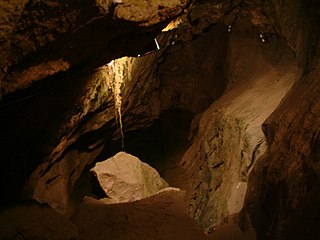Sturmannshöhle
| Sturmannshöhle
|
||
|---|---|---|
| Location: | Allgäu , Germany | |
|
Geographic location: |
47 ° 26 '12 " N , 10 ° 14' 8" E | |
|
|
||
| Type: | Active creek cave | |
| Discovery: | First mentioned in 1815 | |
| Show cave since: | 1905 | |
| Lighting: | electric (since 1905) | |
| Overall length: | 460 meters | |
| Length of the show cave area: |
287 meters | |
| Particularities: | Schrattenkalk ( Helvetikum ) | |
The Sturmannshöhle is a natural karst cave near the Swabian community of Obermaiselstein in the Oberallgäu district in Bavaria .
It is 978 meters above sea level in the Allgäu . The cave has a total length of 460 meters. It is the only accessible show cave in the region.
The Sturmannshöhle is registered as geotope number 780H001.
history
The cave was first mentioned in writing in 1815. By 1904 there were several attempts to explore the cave to the end. In 1904 the Obermaiselstein teacher Eppler explored them up to the watercourse and cave lake. Until 1905 the cave was equipped with iron stairs in the shaft, as well as electric lighting and opened as a show cave.
description
The cave is laid out on a vertical layer joint and shows slit-shaped cross-sections over the entire course. An evenly falling cave floor has formed. The 287 meter long guide path leads through various sections of the cave. From Törle it goes through the dragon gate to the theater , then it goes to the 30-meter-high chimney-shaped eagle shaft , and then via the hell's throat to reach the end of the cave . The total height difference in the cave is 74 meters. The cave has an air temperature of 4 to 8 degrees Celsius in both summer and winter. There are no sintered caves and stalactites in the entire cave. Due to the artificial lighting, ferns and mosses can be seen here and there on the rock walls , which could not exist without artificial light.
The cave, like the neighboring Fallbach cave, is the winter quarters of some bat species such as the great mouse- eared bat , the water bat , the pug bat and the gray long-eared bat .
geology
By the Bavarian State Office for the Environment in 2016 as geoscientific valuable Geotop rated cave was in the Cretaceous Schrattenkalk created. The cave was built at the intersection of a cleft and a steep bed surface. The steep dip in the strata is due to the tectonic deformation of the Schrattenkalke during the unfolding of the Alps in the Old Tertiary . In the process, the rocks were folded and in some cases pushed far into the foothills of the Alps . The Sturmannshöhle was built in an anticline structure , the so-called Schwarzenberg vault . The separating surfaces created by sedimentation or tectonically were enlarged by penetrating carbonic acid-rich rainwater. The dissolution of carbonates at the interfaces is also known as karstification . Especially during the warm periods in the Pleistocene , sand-laden meltwater penetrated the rock crevices and mechanically widened the joints to create pipes and shafts. Such a glacier mill is open in the area of the guide path. The type of the Sturmannshöhle is a karst shaft and horizontal cave.
The karst level that is active today is 40 meters below the entrance level of the cave. When the snow melts , the level of the cave stream or cave lake increases by up to 10 meters. The cave stream flows through the cave lake and leaves the Sturmann cave through a crevice to the east and emerges as a diffuse karst spring near the entrance of the Fallbach cave, which has not been developed for tourists . Both cave systems are hydrologically connected by a siphon . The Fallbach crosses the path from the parking lot to the cave entrance. In the area of the stream bed, tufa deposits can often be observed.
The Sturmannshöhle is now an excursion point in the Allgäu Geopark in the Allgäuer Nagelfluhkette nature park .
- Picture gallery
The driving
literature
- Hans Binder, Anke Luz, Hans Martin Luz: Show caves in Germany . Edited by Aegis Verlag, Ulm 1993, ISBN 3-87005-040-3
- Stephan Kempe: World full of secrets - caves . Series: HB Bildatlas special edition. Edited by HB Verlags- und Vertriebs-Gesellschaft, 1997, ISBN 3-616-06739-1
- K. Cramer: The Sturmannshöhle . Series: Small Writings on Karst and Speleology, Volume 16, 1975
See also
References and comments
- ↑ a b Geotope data sheet 780H001 Sturmannshöhle. In: Geotope research in Bavaria. Bavarian State Office for the Environment, January 25, 2016, accessed on February 6, 2016 . (Attention: Link starts immediate download.)
- ↑ Andreas Zahn: Bat Conservation in Southern Bavaria 2011 - 2013: Investigations into the population development and protection of bats in Southern Bavaria in the period 01.11.2011 - 31.12.2013 . Ed .: Bavarian State Office for the Environment. Augsburg 2015, p. 64 .
- ^ Ulrich Lagally, Stefan Glaser, Elisabeth Jobe, Georg Loth, Andreas Murr, Hubert Schmid, Wolfgang Schmid, Klaus Schwerd, Stephan Sieblitz and Ulrich Teipel: Geotope in Schwaben . In: Bavarian State Office for the Environment (Ed.): Earth science contributions to nature conservation . tape 7 . Augsburg 2009, ISBN 978-3-936385-34-2 , pp. 132 .
- ↑ From the series "Allgäuer Geotopes" we briefly present: The Starzlachklamm near Sonthofen. In: www.geopark-allgaeu.de. Retrieved February 6, 2016 .







